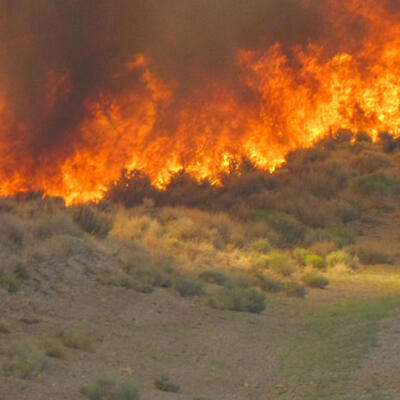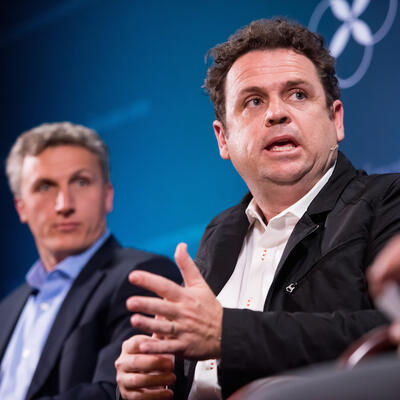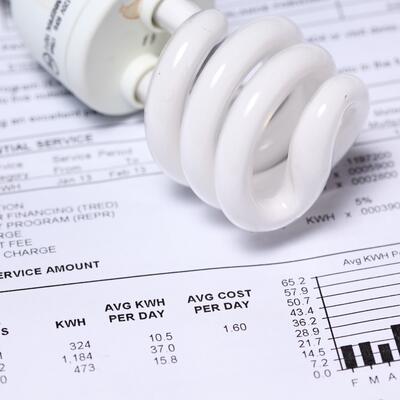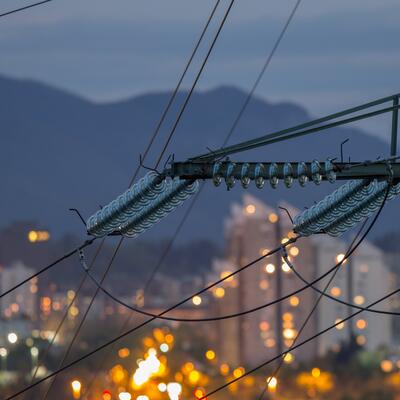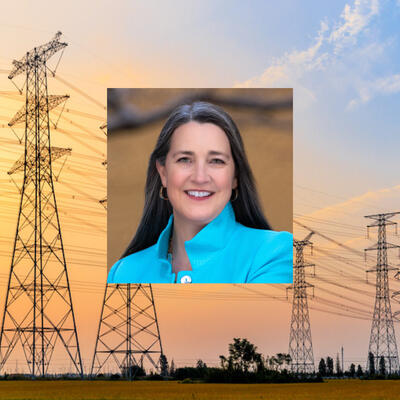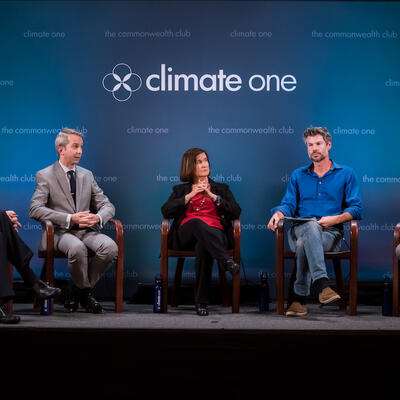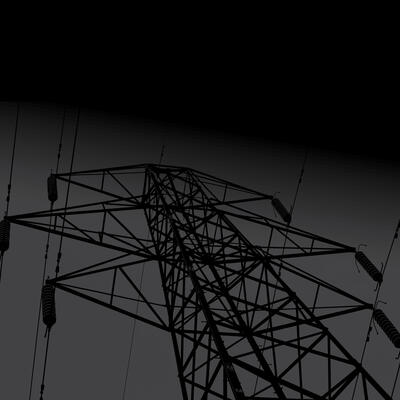
Blackout
Guests
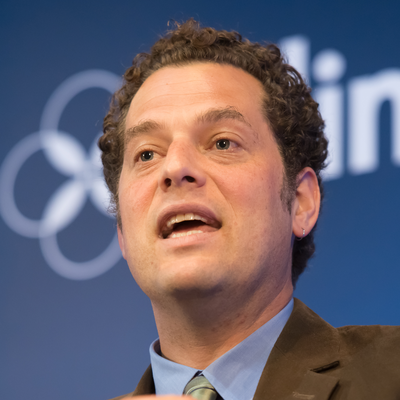
Russell Gold

J.D. Morris
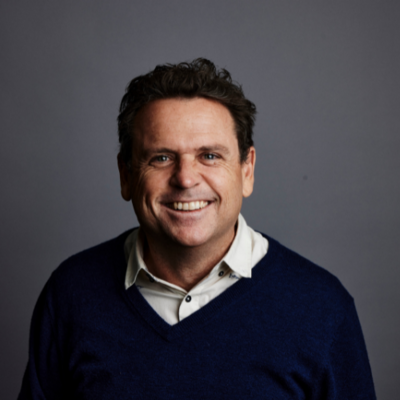
Danny Kennedy
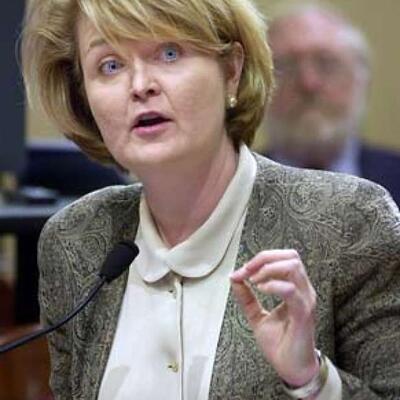
Loretta Lynch
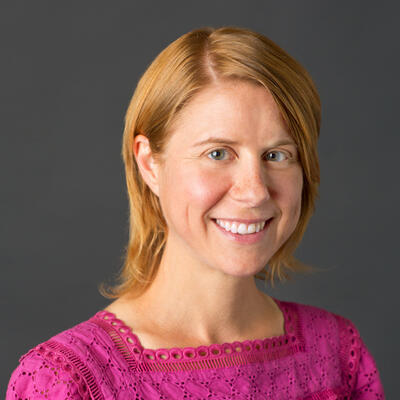
Emily Wimberger
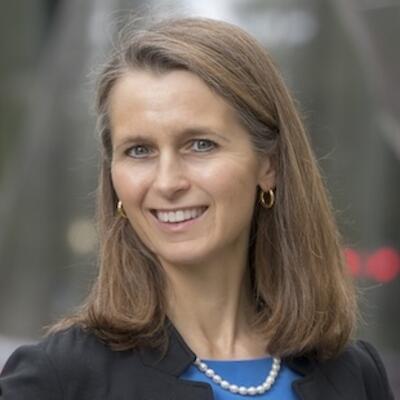
Catherine Wolfram
Summary
The 2018 Camp Fire was one of the most destructive in California’s history, resulting in over eighty deaths and destroying the town of Paradise. Dry weather and hot winds fanned the flames - but the spark that lit them came from a faulty transmission line.
“This was literally a 98-year-old line that runs through a national forest,” says Russell Gold of The Wall Street Journal. “PG&E is not even 100% sure when the last time they inspected that tower was.
“They kept pushing it off, and pushing it off in year after year it sort of became something that they would do next year. And if memory serves correctly, they were planning to do it once again in 2019, until the fire happened in 2018.”
After their aging infrastructure was blamed for a series of deadly wildfires over the past two years, Pacific Gas and Electric, known as PG&E, pulled the plug - literally. The planned power shutoffs were designed to prevent more fires during the state’s driest and most fire-prone months. The move may have prevented fires. But it also sparked anger and frustration, as millions sat in the dark and costs shifted from the company to its customers.
“Definitely the people who are losing electricity are the ones that are bearing the cost,” says Catherine Wolfram of UC Berkeley’s Haas School of Business. “The people that are losing frozen foods, that are unable to run medical equipment…the costs of these outages have been borne by the customers.”
According to former Public Utilities Commissioner Loretta Lynch, problems with the company go back for years.
“No matter how many times we try to make PG&E do the right thing, its corporate culture is so broken and as a corporation it has been adjudged criminally negligent for failing to maintain a system,” says Lynch. “I’m concerned that the rot at PG&E is so thorough and pervasive it can't be fixed. So now we need to change it.”
What’s next for the state’s biggest public utility? And how will California continue to power its future?
Note: Climate One invited PG&E to participate in this program, but over the course of a month they declined to make a spokesperson available.
Full Transcript
Greg Dalton: Hey everyone, I have an exciting announcement. We recently secured a gift of $15,000 to match donations made before the end of the year. As a completely self-funded project of the Commonwealth Club of California, we depend on the generosity of our listeners to provide this weekly podcast. To support more climate conversations like this one, please consider making a tax-deductible donation to climateone-dot-org-slash-donate. Your gift of any amount will be doubled.
Thank you for listening and for your support. Now for this week’s pod.
Greg Dalton: This is Climate One, changing the conversation about energy, the economy, and the environment.
Russell Gold: If you're not paying attention to the way the climate around you is
changing you could miss something. A giant fire, a flood...we are starting to see more and more evidence that our 20th century infrastructure is just not made for the 21st century weather. [:15]
Greg Dalton: Downed power lines and faulty equipment have sparked dozens of wildfires throughout California. Many have been found to be the result of negligence on the part of California’s biggest utility. Their solution? Cutting off power to millions of customers. But who pays the bill?
Catherine Wolfram: Definitely the people who are losing electricity are the ones that are bearing the cost. The people that are losing frozen foods, that are unable to run medical equipment. [:08]
Greg Dalton: Blackouts and the future of California’s power. Up next on Climate One.
---
Greg Dalton: Who’s to blame when the lights go out in California?
Climate One conversations feature oil companies and environmentalists, Republicans and Democrats, the exciting and the scary aspects of the climate challenge. I’m Greg Dalton.
The 2018 Camp Fire was one of the most destructive in California’s history, resulting in over eighty deaths and destroying the town of Paradise. Dry weather and hot winds fanned the flames - but the spark that lit them came from a faulty transmission line.
Russell Gold: This was literally a 98-year-old line that runs through a national forest. PG&E is not even 100% sure when the last time they inspected that tower was. [:10]
Greg Dalton: After their aging infrastructure was blamed for a series of deadly wildfires, Pacific Gas and Electric, known as PG&E, pulled the plug - literally. The planned power shutoffs were designed to prevent more fires during the state’s driest and most fire-prone months. The move may have prevented fires. But it also sparked anger and frustration, as millions sat in the dark and costs shifted from the company to its customers.
According to former Public Utilities Commissioner Loretta Lynch, problems with the company go back for years.
Loretta Lynch: I'm concerned that the rot at PG&E is so thorough and pervasive it can't be fixed. So now we need to change it.
Greg Dalton: On today’s show, we’ll be talking with a number of experts about the future of California’s largest utility. We invited PG&E to participate, but over the course of a month they declined to make a spokesperson available.
My first guests are two reporters who have written extensively about the wildfires: Russell Gold of the Wall Street Journal, and JD Morris of the San Francisco Chronicle. California has had wildfires for decades - but as Russell Gold reported, it’s only in recent years that PG&E has been implicated.
---
Russell Gold: You really have to go back to 2015 and the Butte Fire which was the first major fire that we had seen, where very clearly there was a PG&E line that had started it. I mean going back before that, this wasn't really seen as a Northern California issue. You had instances in 2007 in San Diego, where the Witch Fire was started by some San Diego Gas and Electric lines. But when the regulators looked into the Witch Fire they were like well, okay that’s a Santa Ana winds issue, that’s a Southern California issue. Northern California is different we don't have to have the same precautions, we don't have to ask PG&E to take the same, you know, just level of preparedness.
And 2015 is when that started to really shift, because by 2015, California was about two, three years into the drought. The tree mortalities was becoming more widely understood. But people sort of looked at 2015 and the Butte Fire, it was a large fire but it wasn't particularly destructive. And I think people just look at it and said, you know, this is a one-off issue. PG&E stock did not move very much there wasn’t a panic. And really then 2016 was a quiet year we didn't have any major fires to speak of. And it really wasn't until October 8, 2017, when all of a sudden it seem like the entire area the North Bay and Napa and Sonoma counties was on fire.
The people sort of said well wait a second this wasn't just some sort of, you know, Black Swan in 2015 there’s something going on here and people really started looking at it. And when we did look at it one of the things we found was that PG&E in particular although Southern California Edison also going down the coast into Southern California. Their equipment was starting a lot of fires. They have been required to report since I believe about mid-2014 all the fires that their equipment starts. And this is -- some of them are big fires and some of them are just, you know, small fires that get put out. But the numbers are stunning. When we had a story about this in January, I believe the number was more than one every day, on average of one a day. Now, obviously they’re not spread throughout the year, they are happening in certain times. Which is to give people a sense, this is happening all the time. And then so suddenly reporters the utility the regulators, everyone was starting to look at PG&E in particular and ask themselves, why is this happening? Why are they starting so many fires?
Greg Dalton: And what was the company's response? And where they forthcoming or did they try to sort of hide information, Russell Gold, you did an investigation into this.
Russell Gold: Well, good question. Look, the company very quickly realized that this was in some ways an existential threat for them. The way California laws are written they bear all responsibility for the fire financially. And if they got caught causing a big major fire, that was going to be a major event. And, so you know, to a certain extent they did not, you know, before 2017 before the Wine Country Fires that J.D. was talking about, they really pushed back against it after 2017 I think they took the position, they couldn't claim that they weren't responsible they had to accept it.
But there was one thing that they were not very forthcoming about. Let’s jump forward to the Camp Fire in 2018. They were required to report that they thought that they had started, they may have started this fire. That there was some indications that the fire started under their transmission line. But what they didn't report and what it took just months of digging and going through thousands of pages of filings in Washington DC to begin to understand is that when I first heard about this fire under a transmission line in someplace I never heard of called Pulga, California, you know, I thought okay well this is sort of a modern transmission line, the kind you see every day and it wasn't.
This was literally a 98-year-old line that runs through a national forest. And you know, what's been amazing to me and this is only come out in just like bits and pieces is that PG&E is not even 100% sure when the last time they inspected that tower was. When they climbed up to take a look to see whether the hardware was in good shape. They had actually identified this line the Caribou-Palermo line is a line that they wanted to do maintenance on. But, you know, they kept pushing it off, and pushing it off in year after year it sort of became something that they would do next year. And if memory serves correctly, they were planning to do it once again in 2019, until the fire happened in 2018.
Greg Dalton: J.D. Morris what were the financial incentives that the company had at this time to, you know, spend a dollar on clearing trees or give a dollar to shareholders?
J.D Morris: Well, that kind of gets to the heart of a debate that's raising in California with regard to PG&E right now which is the very model of an investor owned utility itself and whether it is appropriate for PG&E to remain in that way going forward. Currently, the way investor-owned utilities work here and I believe everywhere is the California Public Utilities Commission, which is our state regulator of those entities, you know, has these ratemaking cases that they do like every three years they’ll authorize PG&E to collect a certain amount of money through rates when PG&E makes a proposal saying this is what we want to spend these are the things we want to invest in. But then they have a separate proceeding that deals with, you know, the shareholders return on equity. The profit side of the equation. Because PG&E as an investor-owned utility is not allowed to make a profit from, you know, just selling electricity. But they can make a profit off of the other stuff.
And so they have those proceedings but there's a lot of scrutiny right now about whether, you know, they spent all the money that they were supposed to. They also have a totally separate scenario now, where they have to do these Wildfire Mitigation Plans the Wildfire Safety Plan PG&E calls it. And that process was born out of the 2017 wildfires really. And that's where PG&E and the other utilities are coming in and proposing every year now what they want to spend to make their system, you know, more wildfire resilient. But with PG&E it really shows how much work they have left to do. They are saying if I recall correctly that they want to do system hardening which is basically, you know, covering bare wires and installing more resilient power poles undergrounding and target locations things like that over 7,100 miles of power lines in high fire areas and it's gonna take them 10 years to do that. So to put it in context they have 125,000 miles of power lines across their whole system. So there's a tension there.
Greg Dalton: Russell Gold, I have covered climate for more than 10 years as you know. And PG&E has been one of the most progressive utilities in the country on climate. They backed out of the U.S. Chamber of Commerce because of climate. They have been positioned themselves as one of the cleanest and greenest utilities in the country. And yet, should they have seen this coming, knowing what they knew about climate and given their leadership position on climate should they have started that ten-year project that J.D. Morris just mentioned, 10 years ago because they knew this was coming.
Russell Gold: You know, that's been one of the most fascinating and frustrating parts of reporting the story. And I've been reporting the story nonstop now since November, since the Camp Fire. There is no question that PG&E among all three of the California utilities was a leader on renewable energy procurement. They were amongst the most green utilities in the country. And the California regulators were pushing them to do that. This is a state, this is a utility that fully believes that climate change is happening and was making adjustments, you know, making adjustments to create a climate friendly source of power system.
However, in doing that and sort of thinking about how do we bring in more wind, how do we bring in more solar? How do we accommodate, you know, hundreds of thousands of new rooftop solar installations? They seem to have taken their eye off the ball, on what was happening in their backyard. And, you know, I had a video that I helped put together, and it showed it was just sort of fascinating the lines, the circuits that were causing PG&E the most trouble over a 10-year span, tended to be these very remote lines in places like outside of Paradise, up by Redding, I mean really very remote rural lines. And these were the exact lines, they were in the highest fire threat areas the tier 3 fire-threat areas.
And one of the questions that's come up, is why weren't you paying more attention to these lines. They paid lots of attention to lines that serve big suburban areas, large number of customers, but these lines that were remote and serve very few customers, they were not paying attention to. And you know, the only conclusion you really can reach was they did not see the fire risk coming. If they had seen the fire risk coming and understood the existential threat it posed to them as a company, they must've done something more than this. And so I think the only answer you can come to is they did not understand just how quickly the climate was changing and how much of a problem that was going to be. And one of the big take away lessons I've gotten from this as a business reporter is that for a company like PG&E which is so climate forward which thinks about this and talks about this even PG&E can be caught by surprise by how much the climate around them has changed and the kind of risk that that's presents to them as a company.
Greg Dalton: I've heard Gov. Schwarzenegger 10 years ago, talk about a year-round fire season in California, but it never really penetrated my consciousness or a lot of people until these fires came close to urban areas. We thought it was remote and in non-populated areas. So Russell Gold, what are the lessons for other utilities other companies providing energy around the United States? Because so far that seems, you know, to be isolated in California. What are the lessons if PG&E a green company got surprised by this what the lessons the object lessons?
Russell Gold: That they need to take a really hard look at the risk they're facing. And they need to talk to the regulators and say, look, this might require raising rates. We might have to do some stuff you don't want to do. But if we don't, we’re going to be facing some serious risk. You know, look, you're already seeing this in Florida Utilities which are spending more to harden their systems, because the hurricanes they’re facing are stronger. But, you know, if I were up in the Pacific Northwest very similar situation to what you see in Northern California. If I were in places in the Southeast like Tennessee, which has seen some wildfires that they've never seen before. I’ll be taking a really hard look at my system and addressing these risks.
Greg Dalton: J.D. Morris, we did a conversation earlier this year. I think it was from you I learned for the first time of this idea these public safety shutoffs. The idea that this was so bad that the people would be without power even if they live far away from wildfire areas even if people who live in cities, but their energy comes from some remote area. So, tell us about how this came about the idea and should PG&E have started to “sectionalize” its grid earlier so they can have more granularity in what they turn off rather than, you know, 2 million people.
J.D Morris: Well, first of all I agree with everything Russell just said with regard to you know, the only conclusion you can come to is that they did not understand how fast that risk was evolving. And I think the same statement is true when it comes to sectionalizing the grid certainly.
Greg Dalton: And let me just interject. I've interviewed Cal Fire, forest fire experts and they've told me that what happened in the Camp Fire spread much more faster, much faster than their model. So even fire professionals have been dramatically surprised by the speed and intensity of these fires. So PG&E is not alone in being surprised by this fire, even fire professionals.
J.D Morris: But it was the same story with the Tubbs Fire in Santa Rosa as well. A fire started in Napa and raced across the Mayacamas Mountains and tore into the city of Santa Rosa North of San Francisco and decimated entire neighborhoods killed like 22 people along the way. And no one saw it coming it was moving faster than anyone could handle it. But, I think that yeah getting back to sectionalization to making the grid more targeted and narrowing the parts of it that you can shut off. That is something that they're doing, but like a lot of the wildfire safety measures they are undertaking it takes a long time. And right now, we’re living in a reality where they can't do it that well on a wide scale. And so they are turning off power to millions of Californians. They did that repeatedly in October, after warning that they might do it for a year. But, I think that a very large portion probably a majority of the state was not ready for that to actually happen. And then of course we saw a lot of missteps of PG&E in the way that they executed that.
Greg Dalton: And Russell Gold.
Russell Gold: I was just gonna say I mean the lesson here is that climate change is not a problem that's coming 10 years from now. Climate change is here right now. And we need to either play catch up or try to get ahead of it. But the lesson is that if you're not paying attention to the way the climate around you is changing you could miss something. A giant fire, a flood, along the lines of what Houston experienced with Harvey. We are starting to see more and more evidence that our 20th century infrastructure is just not made for the 21st century weather.
J.D Morris: Exactly.
Greg Dalton: Right. And Russell Gold, we’ll talk later in this podcast about the economic cost of the blackouts and the future of PG&E. And PG&E is clearly in bankruptcy and that's its own rabbit hole in itself. But as a business reporter have you covered the business impact I’m thinking about people who can't get insurance. Property markets, people who are moving out of these areas and saying, look all right this is enough, I'm out of here. I’m gonna sell my house and or you know, move. So what's the business impact of these fires, have you drilled into that?
Russell Gold: Yeah. There are couple various very significant impacts that have happen so far. One, you hit the nail on the head, it's insurance. It is increasingly difficult to get insurance if you own a home in California, especially in what's called the wildland urban interface. And that is going to completely maybe not completely change but it could, but have a very significant effect on the real estate market in California. I mean, what's been happening to date is that the urban areas in California have gotten very expensive, very difficult to build housing, people been in search of less expensive housing been pushed further and further out. I don't think that trend is gonna be able to continue because you're not gonna be able to insure your houses further and further out, if you can insure your houses you won't be able to get federally backed mortgages it’s really gonna have an impact on where people live.
The other big impact that the PG&E bankruptcy had is that PG&E is a utility, I mean this is what we used to call granny stocks. These are very safe and secure stocks that delivered a nice dividend you didn't have to worry about it. All of those owners of the stock were wiped out. Had to sell it at a pretty dramatic loss. Most of PG&E right now is owned by hedge funds that are sort of betting to see which way the outcome goes. So you also had a big financial hit, if your portfolio was large portion of PG&E stocks that you were hoping that were going to really deliver this nice dividends through your retirement, not just was the dividend cut off a year ago and who knows when it comes back to a couple years. Two years ago and it could be easily two more years before the dividend comes back. But the actual value of the stock has just been decimated. So, you know, and both those cases had a very significant impact and will continue to have an impact on people into the future.
---
Greg Dalton: You’re listening to a Climate One conversation about climate change, wildfires and powering California’s future. That was Russell Gold, energy reporter with the Wall Street Journal and JD Morris of the San Francisco Chronicle. Coming up, can PG&E handle the heat?
Loretta Lynch: If you want those four things, safety, reliability, clean energy and at a reliable cost, PG&E has lost the benefit of the doubt and frankly has lost the right to bamboozle us one more day. [:13]
Greg Dalton: That’s up next, when Climate One continues.
---
Greg Dalton: This is Climate One. I’m Greg Dalton, and we’re talking about California’s biggest public utility - Pacific Gas and Electric or PG&E. We invited them to participate, but over the course of a month they didn’t make a spokesperson available.
Suppression of forest fires and climate change has made California a tinder box with unusually low humidity, dry landscapes and mountains loaded with dead and dying trees ready to burn. That raises the stakes when faulty power lines or other equipment spark fires that spread faster and are more devastating than before.
To prevent wildfires, PG&E shut the power off in Northern California, plunging much of the world’s fifth largest economy into darkness for days.
The estimated costs of those outages - called public safety power shutoffs - have ranged from one hundred million dollars to more than a billion. Here to help us put those numbers in perspective are Catherine Wolfram, Professor at the U. C. Berkeley Haas School of Business, and Emily Wimberger, a Climate Economist at the Rhodium Group, which analyzed how big the economic impact of the blackouts is - and who should pay.
---
Emily Wimberger: We’re still doing calculations to try to figure out the overall cost by putting the recent public safety power outages from PG&E in perspective. Rhodium Group did an analysis and really realized even though this seemed like a very large event in California that they don't really rank when it comes to electricity outages nationwide over the past 10 years. Most of those are driven by natural events, hurricanes, I think the top five are all hurricanes. And in terms of operational outages the biggest event on October 26 from PG&E that ranked third in operational outages over the past 10 years nationally. So in terms of the size these outages got a lot of attention, but in terms of the overall size relative to other outages it's actually quite small thus far.
Greg Dalton: Of course there’s a difference between a hurricane which that’s kind an involuntary outage versus there were some operational or voluntary outages in the Southwest in 2011, Puerto Rico, 2016, Texas, 2011 those were much bigger. But what's really happening here, because when there's a fire that's caused by an electricity obviously that can be deadly and people can lose their lives. But that's also a cost borne by the utility and in this case, the utility is shifting the cost on to customers and this is costing utility a lot less, Emily.
Emily Wimberger: Yes. And I think there's been a lot of discussion recently both on the regulatory side, and just operationally from the utilities on who should bear the cost. And what is the infrastructure requirement and who should be paying for these costs in maintaining infrastructure.
Greg Dalton: Catherine, your take on sort of whether this, you know, this is being socialized, whether a for-profit corporation as an investor they kind of pushing the cost on to citizens and taxpayers in California.
Catherine Wolfram: Yeah, definitely the people who are losing electricity are the ones that are bearing the cost. The people that are losing frozen foods that are unable to run medical equipment. At Cal, I think probably the main cost has been just all the time people have had to devote to thinking about alternative plans and moving specimens from one freezer to another. So there's just been a lot of time devoted to trying to salvage things and not have really severe losses from the outages. So the cost of these outages have borne by the customers. PG&E is definitely suffering from these outages though that this has been absolutely horrible public relations for them. The outages themselves and then the fact that their website crashed, so people couldn't check whether they were going to be subject to the outages. It's been, you know, there aren't real costs but they are not immediate cost that they’re bearing but they’re definitely public relations cost. And I think we'll see the results of those as things progress.
Greg Dalton: Yeah. A lot of angry customers and angry voters. Emily Wimberger, is there an upside to the economy people buying batteries and flashlights and maybe diesel generators?
Emily Wimberger: Yeah. Yes, I think there’s definitely been some economic activity associated with this. I'm not sure, I mean economist like to think about the counterfactual. So what would've happened in the absence of these power outages and, you know, both looking at the cost of potential fire risk, and cost borne by yes scene observers being shut down and freezers being shut down, businesses having to close. So I think it's important not just to think about the economic activity of people buying flashlights, but also what would have happened in the absence of these outages.
Greg Dalton: And how about the carbon impact? Is it possible that this is kind of you know, two or three day or five day, kind of recession where the greenhouse gas emissions go down because refrigerators aren’t humming and of course you got the diesel generators working.
Emily Wimberger: You have the diesel generators, yes. And the California Air Resources Board did release some advice about. So if you are in a power outage, here’s the backup generators that you should be using and these are the ones that comply with local air district, air quality regulations. So I think that is an important consideration.
Greg Dalton: Catherine Wolfram, at what point does this become a concern for business? California is a highly regulated state, it is high cost, at what point does electrical uncertainty impact the costs of doing business in California or locating a business in California?
Catherine Wolfram: I think it already has. I mean these have been pretty long outages and yeah, businesses are taking a hit from that. And I'm sure it's entering kind of business people's calculations about how much they want to locate in California, if they have an option to move elsewhere where they don't face this risk. I mean if you have to buy a backup generator that's, you know, a cost that you incur to do business in California that you wouldn't incur in places where these outages aren't happening.
Greg Dalton: Emily Wimberger, clearly PG&E electric utility Northern California is gonna have to invest a lot in its grid. We talk other places in this podcast about sectionalizing it and hardening infrastructure, that's gonna cost money investors might pay for some of that but customer are gonna pay for a lot of that. Is the cost of energy gonna go up even more in California because of these outages or fires?
Emily Wimberger: Well, I think it’s a possibility. And it shows that California really is on the forefront in terms of facing climate impacts. We’ve seen extreme weather events we’ve seen droughts, we've seen catastrophic wildfires. And so this is becoming the new normal in California and that we do need to see energy prices reflecting the probability and the really real risks that we face when it comes to climate change.
Greg Dalton: And Catherine your take on whether this is going to affect, you know, drive up the cost of doing business in California is already a high cost state. And water is gonna cost more because of the infrastructure needed to capture unpredictable rainfall and precipitation. How about energy?
Catherine Wolfram: Yeah. I mean I've seen people talking about electricity prices doubling even and as you say they’re already high in California. I do worry also about there becoming kind of a bifurcated system. Right now we all use the same electricity grid and basically all have the same levels of reliability. And with these outages, at least anecdotally, we’re trying to do more research on this, what you’re seeing is that people who can afford it are buying the Tesla batteries for multiple thousands of dollars or backup generators. Whereas the people who can’t are using flashlights or just getting by without power for a of couple days. So I worried that we’ll have this system where people who can afford it are getting 24/7 reliable power because they're buying kind of these private backup sources of power. And that the grid itself will become kind of less reliable and, you know, it’ll be like whatever. Some people ride the public bus and some people drive Mercedes it will become more quality differentiated.
Greg Dalton: Right. Climate can exacerbate the class and economic advantages and disadvantages in the system. Emily, you’ve done some work with The Climate Impact Lab that maybe touches some of that?
Emily Wimberger: Yeah. And I think it's a really important point to think about sort of the most vulnerable populations. And recently Governor Newsom in California set aside $75 million to address local and state impacts of these outages. So that money is earmarked for the most vulnerable communities. And I think it’s really important to think about income inequality as we look at the impacts of climate change. And we do see extreme exacerbations in communities that are on the forefront of fighting climate and they are the least able to afford it and often face the largest impacts.
Greg Dalton: We’ve been talking about the social and economic cost of PG&E’s planned power outages, with Emily Wimberger of the Rhodium Group and Catherine Wolfram, professor of business at UC Berkeley. This is Climate One. I’m Greg Dalton.
Joining me now are Danny Kennedy, Managing Director of the California Clean Energy Fund. And Loretta Lynch, former President of the California Public Utilities Commission.
Blackouts and wildfires notwithstanding, California remains the world’s fifth largest economy and an economic engine for the country. With PG&E on the fritz, how should California power Silicon Valley and other economic engines in Northern California.
---
Loretta Lynch: Well, we should stop letting PG&E do whatever it wants and stop letting PG&E be a rogue corporation. And instead hold PG&E to account or take it over because our economy and our businesses and our families cannot afford one more day of this corporate negligence.
Greg Dalton: Take it over. The risk doesn't change the state can take over PG&E there’s still lots of risk, there's still lots of capital needs. So I’m not sure the state of California or Gov. Newsom really want to or the taxpayers really want to own PG&E.
Loretta Lynch: Well, we already do. The ratepayers already do on PG&E because the ratepayers give every dime of every dollar that PG&E spends to PG&E. So we’re going to pay as ratepayers one way or the other. And then the question is what can we do to ensure that the system is safe and reliable, and frankly green and at a reasonable cost. And if you want those four things, safety, reliability, clean energy and at a reliable cost, PG&E has lost the benefit of the doubt and frankly has lost the right to bamboozle us one more day.
Greg Dalton: Danny Kennedy, you’re an investor been working in investment for quite a while. Should there be a government takeover of California's biggest utility?
Danny Kennedy: Just to go back to the prior question. We’re going to get to a hundred percent clean energy that’s the law of the land that’s California's legislative intent as well as decarbonizing the other industrial sectors. PG&E to Loretta’s point has failed persistently for the first part of the 21st-century to deliver customer value, safety, reliability. And so what structure and ownership goes forward is to be decided in the coming months hopefully rather than years; it shouldn’t be protracted it can’t be drawn out any further. And municipalization per se or some version of that is a very attractive offer given the leadership being shown by the CCAs, the Community Choice Aggregators in the state that are currently delivering retail to a growing number of citizens and meters will be 70% of the load in the PG&E territory before too long. And the back end of the poles and wires and the rest of the PG&E business could probably be profitably for the state and citizens of California municipalized simply because the cost of debt will be less. PG&E has for so long failed as a company, bankrupt twice and just a couple decades. That it's cause of debt and remember it finances most of its improvements per se if it were to make the choices that we need made with equity and debt. Would be much more expensive than municipal bond debt which would be the way that a public entity would finance the future. So I think there’s a really good case for that. It needs to be decided and directed by the state government who has to take control of the situation before we have more crises.
Greg Dalton: The mayor of San Jose along with the mayor of Oakland, Sacramento have a proposal, Loretta Lynch to kind of basically make a co-op, you know, which sounds a little bit like something organic grocery stores, something from the 70s. But what is a co-op and do you think that really will gain traction mayors of the biggest cities, some of the biggest cities two of the three biggest cities in the Bay Area saying we want to take it over.
Loretta Lynch: I applaud Mayor Liccardo and all the mayors and supervisors who have put a very serious proposal and a way forward on the table. Here's our problem, no matter how many times we try to make PG&E do the right thing its corporate culture is so broken and as a corporation it has been adjudged criminally negligent for failing to maintain a system. I'm concerned that the rot at PG&E is so thorough and pervasive it can't be fixed. So now we need to change it. Plus, the billions and billions of dollars California needs to invest in our system to make it safe because PG&E has failed to make those investments even when they been ordered to. Those dollars should be best spent dollar for dollar on safety and reliability and not on corporate profits. Right now PG&E has a 12% profit so that means over and above all of its excess spending $.12 of every dollar goes to the shareholders. That $.12 could be put back into the system to make it safer and more reliable if we had government ownership of the electric system. And, you know, it’s not an untried radical idea. In every state of the nation we have public ownership of electricity companies. And we do in California, LADWP and SMUD and Palo Alto.
Greg Dalton: Sacramento, Los Angeles, kind of municipal utility.
Loretta Lynch: Municipal utility it’s about 20% of our electricity in California right now today is being provided by government owned utilities. So this is an everyday occurrence that is eminently doable and it is time to do it here and now with PG&E.
---
Greg Dalton: We’re talking with Danny Kennedy of the California Clean Energy Fund and Loretta Lynch, formerly with the California Public Utilities Commission. I’m Greg Dalton. When we come back, we’ll look at some possible solutions to California’s power problems.
Danny Kennedy: There are better technologies, there are better ways of running electricity companies. And the fact of the matter is we haven’t as a state decided to do that. We’ve talked about it, but we keep on making Humpty Dumpty all over again. [:12]
Greg Dalton: That’s up next, when Climate One continues.
---
Greg Dalton:This is Climate One. I’m Greg Dalton. We’re talking about powering California’s future, with Loretta Lynch, former Public Utilities Commissioner, and Danny Kennedy of the Clean Energy Fund.
After racking up thirty billion dollars in debt, PG&E filed for bankruptcy in early 2019. In summer California had its hottest July on record and even more wildfires, for which the utility was forced to admit responsibility. Things seem to be going from bad to worse for PG&E, and climate change isn’t helping. With more extreme weather events happening around the country, is this a cautionary tale for other states?
---
Danny Kennedy: As far as the climate impacts go, I think really we’re seeing the weakness in our institutions to deal with the extreme weather related change that we’re gonna see across the board across the country across the globe. And the fact that we need to move faster in these times. When things are not working they need solutions. There are better technologies, there are better ways of running electricity companies. There are better ways to finance the investments need to make them resilient in this day and age of climate change. And the fact to the matter is we haven’t as a state decided to do that. We’ve talked about it for a few years now, but we keep on making Humpty Dumpty all over again. And until we decide to move and get the entrepreneurs engaged, which is my business that have the technology have the solutions to build better cleaner, cheaper clean energy answers to these problems, you know, we’re gonna just see it repeat, deja vu.
Greg Dalton: So all of a sudden there’s been a lot of talk renewed interest in battery local storage people wanna put if they have solar add some batteries so you can generate sunlight energy in the daytime use it at night from your battery. But there's also lots of diesel generators we hear about micro grid, sectionalizing the grid so that it can be turned off in smaller areas. Danny Kennedy, where is that technology gonna happen and who's gonna pay for it?
Danny Kennedy: Well look, you know, the technology is available now to micro grid things to provide battery backups to circuits that are critical to resilience and to, you know, critical needs. There’s ways that everyone’s home or hospital or multitenant dwelling can be insured whether that’s, you know, plugging your vehicle into the harm or whatever the case may be. We know how to do that it’s not that hard. It does require new business models it does require new contractors to deliver and it does require some new technologies. And that's good, that's an option to grow a business. The bigger question right now is whether we’re gonna reorganize the entity to deliver those solutions rather than just go back to a 13% rate based profit on a transmission upgrade which will cost billions of dollars and not actually enact any of these modern technologies, but rather go back to the 20th century formula they’ve fallen back on before.
And whether we’re gonna have the political will to really drive that change and adopt these entrepreneurial solutions that are available.
Where are they gonna come from? They’re gonna come from other parts of California, San Diego has been doing better than we have in terms of fire safety and so on. But also all around the globe I mean micro grids are now being pioneered in a way that Silicon Valley can only gaze at in awe in Africa and India, you know. So we’re gonna learn lessons for how to do this right from the globe and we should be proactively reaching out and trying to seek those startups to come to these shores to build those businesses right now. But we’re still sending mixed signals about whether we want them at all or whether we’re just gonna recreate the problems we've had for decades.
Loretta Lynch: Well and the reason we’re sending mixed signals is because PG&E captured its regulators. So the regulator is a lapdog not a watchdog, and the regulators focused on what does PG&E want and what is good for PG&E. That has to stop. We need to right now ask the question what is good for California and what is California need and want. What do the workers want the victims of those wildfires. The ratepayers, the environmentalist, everyone all businesses and families. And Danny is right the technology is there and the price is dropping every day. It is so technologically feasible, financially feasible and legally feasible to get to that advanced energy electric system that California needs that what’s standing in the way are the complicit regulators and the corrupt corporations.
Greg Dalton: And that’s not unique to California. There's lots of regions around this country where public utilities commissions are good old boys with the local utilities, particularly in the South. So Loretta Lynch, what are some of the broad lessons of the California wildfires and running our electrical economy in this digital age for other states and other parts of the country?
Loretta Lynch: Well, look around. We are not unique in California or Northern California of having dry, mountainous wildfire ready conditions but only PG&E has experienced the problems that we’ve experienced throughout California. And that's because the regulator became a lapdog and allowed PG&E to do whatever it wanted. And what it did was cut corners on maintenance and safety, pocket the money, send it out for dividends to shareholders as Judge Alsup required PG&E to come in and talk about after the first horrible wildfire in 2017, PG&E has paid out over $5 billion in dividends instead of fixing its system or paying the victims.
Greg Dalton: Well that's what it’s set up to do and it’s easy to say, you know, there’s been a lot of talk about hedge funds coming into PG&E, etc. but some of the largest owners of PG&E are the Vanguard Total Stock Market Index Fund, CalPERS, the California Public Employee Retirement System, T. Rowe Price, mid-cap value fund. These are retail investors traditionally, people who invest in utilities are people who want steady income, they clip coupons. And so, you know, these are like teachers and average Americans who invest in utilities because they think they're safe and they're the ones who are receiving those dividends. So some of them are going to average Americans.
Loretta Lynch: Absolutely and some of them are going to hedge fund speculators and bottom feeder vulture funds who came in after PG&E chose bankruptcy and scooped up that stock at pennies on the dollar. But what we know is this, even though the ratepayers have paid at top dollar Cadillac prices to ensure a safe system what they got was a jalopy broken down system because PG&E cut corners and the regulator did not hold them to account. I know, I was a regulator who tried to hold them to account, and their choice was to file bankruptcy to get out from under our requirements to trim their trees and fix their system because they wanted to pocket that money. So you could argue that all those investors for the last 15 years have over earned because they were getting dividends assuming the system was safe when the system wasn't safe. So now those investors frankly have to pay for those years of over earning because California must have and should insist on a safe, reliable, clean and relatively cost-effective system and it doesn't have that with PG&E today.
Greg Dalton: Right. And investors have paid two years ago the stock was at 70 today it's around six dollars. So somebody's lost a lot of money there those investors. Danny Kennedy.
Danny Kennedy: I was just gonna say one of the lessons for the rest of the country that should be paid attention to is around FERC regulation the Federal Energy Regulatory Commission, which does the transmission regulations. And some of these fires are transmission related, it looks like the most recent serious ones, potentially. And, you know, they're the ones that are allowing a 13% return on investment or more which is something that investors are sort of counting on and yet that technology set is letting us down in these wildfire prone conditions where we have people living the interfaces it’s called. And so we need to think about that as a national lesson. How do we create protected micro grid for towns like Paradise rather than building lines into them through forests all that sort of stuff. And right now the incentives unfortunately, from FERC are to build the transmission anew and put that on the rate base because they’ll make 13% out of it or better.
Loretta Lynch: Or more. Edison is asking for 17% for new transmission line. So as long as FERC hands out carrots at every turn and does not employ the sticks that they have legally available to them the companies are gonna eat the carrots and we all will pay.
Greg Dalton: But this is a fundamental challenge to a lot of the plans to green the grid to have large industrial scale solar or wind projects far away from populations and then transmit them the electricity to the called load centers. The urban populations. I recently interviewed the public lands Commissioner of Washington State. There is most people live along the coast around Seattle there’s a lot of wind in Eastern Washington that they’re developing. I’ve driven there recently and that means a lot of transmission lines over the Cascades, which are a tinderbox. So at some point these fires, Danny Kennedy, challenge the greening of the grid because of these big renewable projects faraway in warm in hot places across timber.
Danny Kennedy: I don’t think it challenges the greening of the grid. I think it challenges the assumption that you’re gonna do the greening of the electricity supply through utility scale projects only. If they’re dependent on transmission the transmission is going to cause the problems then we’re gonna think of a different solution. Lo and behold, renewables are wonderful because they’re distributed technologies and the lowest cost we have deployment is actually at the point of use. So let's get more interstitial deployments of wind, solar, storage happening. Let's do more rooftop let’s do more commercial.
Greg Dalton: Rooftop is -- but economists would say rooftop is more expensive than something big industrial scale out in the --
Danny Kennedy: Economist would say the installation of a utility scale solar plant is less than the installation of a rooftop solar plant. But the cost of transmission and the other elements that are required to get the power market are greater than the cost to get the power to market when it's on the roof. And they come out actually very competitive it's all about the design choices you make and what the regulators want. And if you want green and you want safe to your point exactly, Greg, you might end up choosing not to do the large scale utility as much as we are currently pending to do and you go more towards the distributed. A truly green grid will be one that is distributed in large part, not entirely it’s not either or in any of these cases, we tend to try to simplify it, it’s gonna be both end. There will be transmission in the future. But let's not incentivized to Loretta's point transmission which is dangerous simply for return on the --
Greg Dalton: And the cost of transmission has change it’s gone up dramatically the risk around it.
Loretta Lynch: Well, the only reason it's gone up is because FERC’s been allowing extraordinary and I would argue exorbitant profits. But I agree with Danny that the grid of the future if we want it green and cost effective and safe has to include much more of a distributed element than it does today. And those economists that you are talking about, Greg, those economists are back in the cassette tape era. They are planning a command-and-control system that is region wide or even west wide and instead we have to look at all of the costs that they're not taking into account. We have to take the blinders off and not just look at what the utility pays but what our economy pays. The prime example happened two weeks ago when PG&E blacked out over 2 million of its customers as a precautionary tale and still had a fire.
Greg Dalton: Wouldn’t been more fires if they didn’t do it?
Loretta Lynch: We don’t know. But what we do know is this, 2 million customers had real economic damage that those economists you’re talking about when they look at the value and the viability of a transmission line versus a rooftop solar are not taking into account. And those real economic damages fall much more heavily on the poor and working-class. So if your refrigerator spoils, lots of people who have second houses can go afford to restock. But people who are on food stamps cannot and those people then don't eat and those economists are not taking that real world extraordinary cost into account.
Greg Dalton: We talked to an economist earlier in the show who looked at some of that. But you're right, climate makes disparities worse the poor gets screwed worse with climate than they typically do. So of the fires that happened recently I believe seven of the 10 worst fires recently have become because of, had happen because of electrical lines. Not just PG&E there was the 2018 Woolsey Fire that was Edison three people killed 97,000 acres, 1,500 structures burned. So Loretta Lynch what about other utilities, you know, PG&E, perhaps rightly so gets a lot of the criticism, but it also was Edison which powers much of Southern California.
Loretta Lynch: And I lay that at the feet at the feet of the complicit regulators. When the regulators let the utilities run amok and they don't even take any evidence or facts about what works and what doesn't work then we’re gonna have these problems. So environmental groups went to the PUC to say we would like to put experts in the administrative trial we’d like to introduce experts and expert testimony about what really mitigates wildfires. And the PUC said no and instead they rubber stamped the utilities wildfire mitigation plans as filed.
So what we’re going to do in California again is spend hundreds of millions of dollars to change out wood poles to steel poles and not cover the conductors which are the actual source of the fire and not change out the old equipment that's attached to those poles that spark and light the fire. So it's not wood versus steel poles it's all the equipment and the lines and the old lines, but because the utilities will make more money changing out a wood pole to a steel pole and make very little money changing out an old conductor to a new conductor California has now embarked courtesy of regulatory complicitness on a program that's $1 billion in cost that is actually not gonna mitigate any wildfires.
Greg Dalton: This is all going in a very kind of local almost kind of tribal way where it seems like people there’s an incentive here for communities to generate their own electricity have their own storage so they could be an island when bad things happen, right.
Loretta Lynch: Except that's why the mayor's proposal, 24 mayors and supervisors throughout PG&E territory from Stockton to Reading to San Jose to Marin county --
Greg Dalton: Hundreds of miles in between.
Loretta Lynch: Hundreds of miles in between are saying, hey, let's band together for the common good. Let’s band together for the people let’s band together for local energy democracy. We don't necessarily need a monopoly but we do need as a society to ensure that every single California family and business has access to clean, safe, reliable energy at an economic price. And so what you don't want to do is cream off the biggest companies or cream off the wealthiest people who have real reliable energy and leave all of the rest of us in a Third World Banana Republic run by PG&E and its cronies. So what we have to ensure is equity across the board and we've gotten that right in other arenas we can get it right here and that's why the mayor's proposal is so exciting and frankly groundbreaking because they're gonna take those advanced technologies that Danny's been talking about and that are here now. And they could implement them in different ways to solve for their individual community needs but as a group what’s not to like about that?
Greg Dalton: You’ve been listening to Climate One. We’ve been talking with Loretta Lynch, former President of the California Public Utilities Commission, and Danny Kennedy, Managing Director of the California Clean Energy Fund.
My other guests today were reporters Russell Gold of the Wall Street Journal and JD Morris with the San Francisco Chronicle. Economists Emily Wimberger of the Rhodium Group and Catherine Wolfram, Professor of Business Administration at UC Berkeley. We invited PG&E to participate in this program but the company didn’t make a spokesperson available.
Greg Dalton: To hear more Climate One conversations, subscribe to our podcast at climateone.org or wherever you get your pods. Please help us get people talking more about climate by giving us a review or rating.
Thank you for listening and for your support.
Greg Dalton: Kelli Pennington directs our audience engagement. Tyler Reed is our producer. Sara-Katherine Coxon is the strategy and content manager. The audio engineers are Mark Kirchner, Justin Norton, and Arnav Gupta. Anny Celsi edited the program. Dr. Gloria Duffy is CEO of The Commonwealth Club of California, where our program originates. I’m Greg Dalton.
